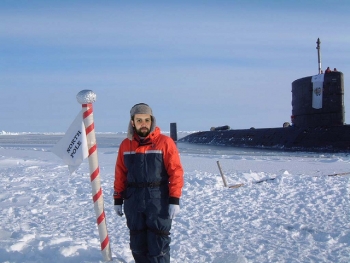Great Adventures

Man has always wanted to explore, to travel to places that no one else has ever seen. For an explorer the most important thing is to be the first. It may be the North Pole, the South Pole, the Amazon, but he must be the first person to get there. In earlier times, without modern communications, it was not always certain who was actually the first. One of the best examples of this is Robert E. Peary`s expedition to the North Pole in 1909.
Before Peary set out, he already had several years of experience in the far north. For the North Pole, he organized a large expedition but planned to travel like Eskimos. It was a very difficult journey, 1,300 kilometres over the Arctic Ocean. Dog teams pulled heavy sleds with supplies over the ice. When the sleds were empty, Peary told the Eskimo drivers to return. At last, on April 16 Peary reached the North Pole. With him were Matthew Hansen, a black man, four Eskimos and 38 dogs. In his diary Peary wrote, “The Pole at last!!! My dream for 23 years.”
Unfortunately, when Peary returned to the United States, he discovered that another explorer Dr. Frederick Cook, claimed that he reached the North Pole the year before. This was the beginning of a long dispute among scientists about who was the first to reach the North Pole. Today most experts agree that Peary, not Cook, was the first to get to the top of the world. There was also a race to get to the South Pole , although there is no dispute about who got there first. In late 1911 British explorer Robert F. Scott set out across 1,400 kilometres of snow and ice. After a hard journey of 78 days Scott reached the South Pole where he found the flag of Norway which explorer Roald Amundsen left there five weeks earlier.
Sadly, Scott and his men did not return from their expedition; their bodies, and Scott`s records, were found a year later. Today the U.S. Amundsen-Scott Station that stands at the South Pole is named for both explorers. The North Pole is still an attraction. Since Peary`s expedition in 1909, men have travelled to the Pole in other ways. Richard E. Byrd flew over the North Pole in 1926. The world`s first nuclear submarine, the Nautilus, passed under it in 1959. Ralph Plaisted rode a snowmobile to the Pole in 1968. The Soviet Union`s nuclear icebreaker Arktika got there through the ice in 1973. But although modern technology is important, it helps man in many ways, it is still exciting when someone sets out alone. In 1986 a Frenchman, Jean-Louis Etienne, got on a pair of skis and skied to the North Pole
The Amazon is also an attraction for people who are looking for adventure. This great river goes across most of the continent – from the Andes to the Atlantic Ocean. It is known that the upper part of the river is not navigable. But what about a kayak? In 1987 a Pole, Piotr Chmielinski, led a group from the upper part in the mountains to the ocean, 6,000 kilometres away. They used kayaks when possible, carried them when there were too many rocks. It took them six months to reach the ocean. Flying is another adventure that has always attracted men. But for some people there is nothing exciting about flying in a modern jet plane, and they are experimenting with simple flying machines, ultralights, as they are called. They fly only 40 kilometres an hour and look very much like the Wright brothers` first plane – cloth wings and an engine. But how safe are they? As Wilbur Wright said about flying in 1901, “… if you are looking for perfect safety, you will do well to sit on a bench and watch the birds.”
